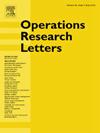论线性和凸二次方程程的丹齐格单纯形方法的枢轴数
IF 0.8
4区 管理学
Q4 OPERATIONS RESEARCH & MANAGEMENT SCIENCE
引用次数: 0
摘要
本文完善并扩展了 Ye 和 Kitahara-Mizuno 的工作,提出了关于求解 Leontief 类线性程序、某些 P 类线性互补问题和非负约束凸二次型程序的单纯形方法的枢轴数的新结果。我们的研究结果有助于进一步理解求解这些问题的单纯形方法的复杂性和效率。本文介绍了二次编程结果的两个应用。本文章由计算机程序翻译,如有差异,请以英文原文为准。
On the number of pivots of Dantzig's simplex methods for linear and convex quadratic programs
Refining and extending works by Ye and Kitahara-Mizuno, this paper presents new results on the number of pivots of simplex-type methods for solving linear programs of the Leontief kind, certain linear complementarity problems of the P kind, and nonnegatively constrained convex quadratic programs. Our results contribute to the further understanding of the complexity and efficiency of simplex-type methods for solving these problems. Two applications of the quadratic programming results are presented.
求助全文
通过发布文献求助,成功后即可免费获取论文全文。
去求助
来源期刊

Operations Research Letters
管理科学-运筹学与管理科学
CiteScore
2.10
自引率
9.10%
发文量
111
审稿时长
83 days
期刊介绍:
Operations Research Letters is committed to the rapid review and fast publication of short articles on all aspects of operations research and analytics. Apart from a limitation to eight journal pages, quality, originality, relevance and clarity are the only criteria for selecting the papers to be published. ORL covers the broad field of optimization, stochastic models and game theory. Specific areas of interest include networks, routing, location, queueing, scheduling, inventory, reliability, and financial engineering. We wish to explore interfaces with other fields such as life sciences and health care, artificial intelligence and machine learning, energy distribution, and computational social sciences and humanities. Our traditional strength is in methodology, including theory, modelling, algorithms and computational studies. We also welcome novel applications and concise literature reviews.
 求助内容:
求助内容: 应助结果提醒方式:
应助结果提醒方式:


